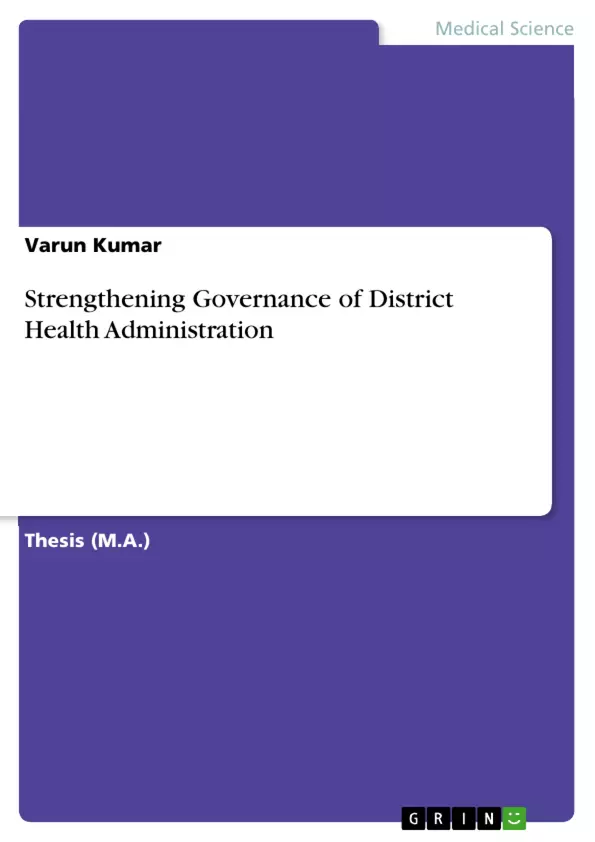In recent years, the governance of the health system has become a key issue of discussion for international organisations such as the WHO, the WB, UNDP, USAID and the EC. Furthermore, they state that spending on health would not alone achieve the intended results in health without addressing governance.
The District Health Administration (DHA), generally called the office of the Civil Surgeon in Bihar, India, is considered a bridging administrative unit from national and state government to the community at village level. Moreover, this is a full-bodied unit with management and the administrative power under the leadership of Chief Medical Officer/Civil Surgeon and Assistant Chief Medical Officer with various health programme officers and support staff. Although health service delivery is seen to have improved in Bihar in recent years, issues such as leadership, management, accountability and transparency would seen to be weak in the DHA.
This study aims to recommend specific strategies to strengthen governance of the DHA in Bihar. In doing so, it first identifies and critically analyses the causes of poor governance of the DHA. Moreover, it reviews theories and documented effective examples of strengthening governance in the district level health systems in low and middle income countries. This study finally analyses various strategies for strengthening governance and outlines appropriate governance for the DHA in Bihar.To undertake this study, a framework for strengthening governance developed by Brinkerhoff et al. (2008) is used, which covers leadership and management capacity, accountability, community participation and transparency in decision making. The methodology primarily involves reviewing secondary data; however, a number of health and development professionals and legal experts were contacted to obtain a number of practical experiences.
Inhaltsverzeichnis (Table of Contents)
- CHAPTER ONE: INTRODUCTION TO DISSERTATION: FRAMEWORK OF STRENGTHENING GOVERNANCE OF HEALTH ADMINISTRATION -
- 1.1 Introduction
- 1.2 Background and rationale
- 1.3 Aims and objectives
- 1.4 Output of the dissertation-
- 1.5 Methodology
- 1.5.1 Type of dissertation-
- 1.5.2 Search strategy-
- 1.5.3 Sources of data.
- 1.6 Governance and its framework.
- 1.6.1 Definitions of governance
- 1.6.2 Governance in health sectors
- 1.6.3 A framework of strengthening governance ·
- 1.6.4 Possible effects of good governance of the DHA in Bihar-------
- 1.7 Limitations
- 1.8 Target audience
- 1.9 Structure of the dissertation-
- 1.10 Summary.
- CHAPTER TWO: OVERVIEW OF THE STATE, PROBLEMS AND ISSUES OF GOVERNANCE IN THE DHA
- 2.1 Introduction
- 2.2 State background
- 2.3 District health system and its links with PRIS
- 2.4 Structure and functions of the health department -
- 2.4.1 Organisational structure and functions of the DHA with its links to the department of health and family welfare, Bihar (DHFW)
- 2.4.2 Major functions of the DHA-
- 2.5 Problem analysis of governance in the District Health Administration
- 2.5.1 Introduction
- 2.5.2 Weak leadership capacity-
- 2.5.3 Weak management capacity-
- 2.5.4 Poor accountability to the public.
- 2.5.5 Low Participation of people in decision making and planning.
- 2.5.6 Poor transparency in decision making--
- 2.6 Summary-
- CHAPTER THREE: STRENGTHENING GOVERNANCE OF HEALTH ADMINISTRATION: THEORIES AND PRACTICAL EXPERIENCES -
- 3.1 Introduction
- 3.2 Theories and documented examples on governance in health administration
- 3.2.1 Improving leadership capacity--
- 3.2.2 Improving Management Capacity
- 3.2.3 Promoting accountability--
- 3.2.4 Increasing community participation in decision making and planning-23
- 3.2.5 Ensuring transparency in decision making---
- 3.3 Summary
- CHAPTER FOUR: APPLICATION OF THEORIES AND THE PRACTICAL EXPERIENCES IN THE CONTEXT OF BIHAR
- 4.1 Introduction
- 4.2 Strengthening governance of the DHA in Bihar-
Zielsetzung und Themenschwerpunkte (Objectives and Key Themes)
This dissertation explores the governance of District Health Administration (DHA) in Bihar, India, examining its current structure, challenges, and potential for improvement. It aims to identify key areas for strengthening governance, drawing upon theoretical frameworks and practical experiences from other contexts.
- Strengthening governance of the DHA in Bihar
- Analyzing the current structure and functions of the DHA
- Identifying key problems and issues in the governance of the DHA
- Exploring theoretical frameworks and practical experiences for strengthening governance
- Developing recommendations for improving the governance of the DHA in Bihar
Zusammenfassung der Kapitel (Chapter Summaries)
Chapter One introduces the dissertation, outlining its background, rationale, aims, objectives, methodology, and the framework for strengthening governance in health administration. This chapter also defines governance in the context of health sectors and explores the possible effects of good governance on the DHA in Bihar. Chapter Two provides an overview of the state of Bihar, the structure and functions of its health department, and a detailed analysis of problems and issues related to governance in the DHA. Key areas of concern include weak leadership capacity, poor management capacity, lack of accountability, limited public participation, and lack of transparency in decision-making. Chapter Three delves into theoretical frameworks and documented examples related to strengthening governance in health administration. It explores strategies for improving leadership capacity, management capacity, promoting accountability, increasing community participation in decision-making and planning, and ensuring transparency in decision-making processes. Chapter Four applies the theories and practical experiences discussed in Chapter Three to the specific context of Bihar. This chapter focuses on developing recommendations for strengthening governance of the DHA in Bihar, taking into account the unique challenges and opportunities presented by the state's context.
Schlüsselwörter (Keywords)
This study focuses on the governance of the District Health Administration (DHA) in Bihar, India. Key areas of interest include leadership capacity, management capacity, accountability, community participation, transparency, health systems strengthening, and the role of the Primary Health Centers (PHCs) in providing healthcare services. The dissertation also examines the impact of governance on the overall health outcomes in Bihar and explores strategies for improving the governance of the DHA to enhance its effectiveness and efficiency.
- Citar trabajo
- Varun Kumar (Autor), 2008, Strengthening Governance of District Health Administration , Múnich, GRIN Verlag, https://www.grin.com/document/157954



